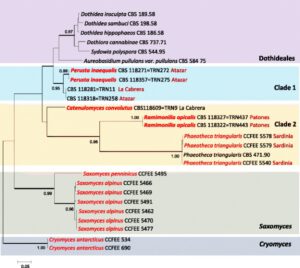Perusta inaequalis Egidi & Stielow, in Crous et al., Fungal Systematics and Evolution 3: 130 (2019)
Synonym: Perusta inaequalis Egidi & Stielow, Fungal Diversity 65: 155. 2014. Nom. inval., Art. 40.7 (Shenzhen).
Etymology: Named after the unilaterally inflating conidium-like cells.
Diagnosis – Colonies growing up to 80 mm, black in reverse, greyish in obverse, darker near the margin, not uniform in color, compact, hard, with irregular margins. Hyphae dark brown, septate, finely guttulate, with thick walls, consisting of round and chained cells with lateral germination (Fig. 12g, arrow). Conidiophores semi-macronematous; conidiogenous cells intercalary. Conidia globose, catenate, dark brown. Teleomorph unknown.
Notes — Clade 1 was composed of four strains. Strains CBS 118271 and 118357 were isolated from the same locality in the central mountain range in Spain, showing 100 % ITS similarity; for this reason, they are ascribed to the same species.
Typus – Spain, Atazar, from rock (holotype CBS 118271, culture and specimen preserved as metabolically inactive).

Figure 1 – Perusta inaequalis CBS 118271 = TRN272. e Colony appearance. f Conidiophores and intercalary conodiogenous with globose, catenate, dark brown conidia. g–h Guttulate, dark brown hyphae with lateral germination (G, arrow).

Figure 2 – ITS tree of species of Dothideales: Phaeotheca triangularis, Saxomyces and Cryomyces genera resulting from Bayesian analysis. Bayesian probabilities of ≥95 % are provided above corresponding nodes and in a thicker line. Clades are indicated with colored blocks. In the brown text, Mediterranean localities are indicated. Strains isolated from rocks are indicated in red text, and species described here for the first time in names in red bold text
